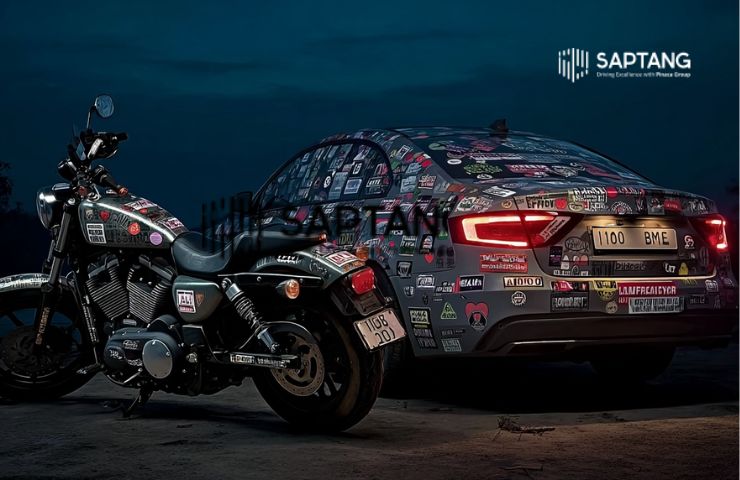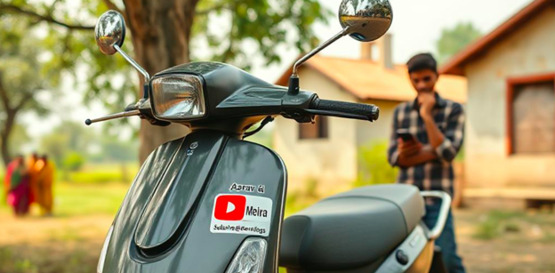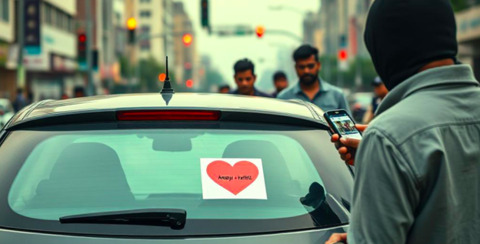
Protect It Before It’s Too Late
By Hariharan R, Cyber Researcher
In our everyday life, we often do things with love and pride. We paste our children’s names on our vehicles, write our lover’s name inside a heart symbol on the back of the car, or even proudly showcase our village or social media handles on the number plate. It feels sweet. It feels personal. It looks stylish.
But do you ever stop and ask yourself: “Is this safe?”
We live in a world where everyone is connected, but not everyone is kind. Some people are quietly watching, not to appreciate or support you, but to gather information, connect dots, and plan something harmful.
Today, through this article, I want to bring your attention to a simple but risky behavior that many of us do unknowingly, sharing personal information on our vehicles.
We often don’t realize how names, phone numbers, YouTube channel IDs, or even village names pasted on our vehicles can be used by someone for the wrong purpose.
Dear readers, please read this fully, with attention and care. Because what you read here might help you protect your loved ones someday.
Take a look around the next time you’re on the road or in a parking area. You’ll see:
At first, it looks innocent. But from a security point of view, it’s dangerous. You are giving away small puzzle pieces to strangers, and in today’s digital world, even a small piece of information can be misused.
Let’s explore this through two fictional examples inspired by real-world scenarios.

In a calm village in Tamil Nadu, an elderly man of around 68 years was living a peaceful retired life. He had worked for the railways for over 35 years. Now, he was spending his time with his son, daughter-in-law, and two lovely grandchildren. His life was simple, early morning tea, reading newspapers, playing with kids, and watching devotional and travel videos on YouTube at night.
One evening, around 9:30 PM, while watching videos on his smartphone, he received a call. The person on the other end spoke politely and said,
“Sir, we are calling from your bank. This is a regular KYC verification call. We will send you an OTP, please share it with us.”
The old man, trusting the voice, shared the OTP.
Within minutes, his phone screen went blank. Then came a message, “₹12,95,000 withdrawn successfully.” He was shocked and confused. The entire savings he had built over the years were gone in seconds.
But how did this happen?
Let’s go back a few months.
A young man had visited the same village for his college friend’s wedding. He noticed the old man’s scooter parked outside a small shop. It had a sticker:
“Grandpa of Meera & Harish – Subscribe to their YouTube Channel: @MeeraHarishVlogs”
Out of curiosity, the young man checked the channel. He saw home videos of the kids, birthday parties, school names, family events – all uploaded with love. From these, he found the exact house, the school names, and guessed the location. Then, using OSINT (Open-Source Intelligence), he:
Traced the phone number linked to the YouTube account
Identified the old man’s full name through Aadhaar-related data leaks
Saw pension-related details from public forums
Found the bank where his pension was coming from
All these details came together like a puzzle. What started as curiosity turned into a plan. The hacker waited and made the call at the perfect time, with perfect words.
The family never imagined that a cute sticker on a scooter would become the starting point of a financial disaster.

In a metro city like Bengaluru, 26-year-old Ananya was living her dream. She was an engineer working in a top MNC, driving her own car, and living independently. Her smile, her confidence, and her success made her stand out wherever she went.
One weekend, Ananya’s boyfriend surprised her. He wrote on the back of her white car:
“Ananya ❤️ Karthik – Forever”
She was touched by the gesture and even posted a story on Instagram, smiling near the car.
But what looked romantic to her caught the attention of the wrong people.
In the same city, a criminal gang involved in illegal activities noticed her car regularly. One member jokingly asked his hacker friend to find out who the “Ananya” on the car was. The hacker took it as a challenge.
From just two names and the car number, he began his research. Using OSINT and social media tools, he discovered:
It took him just 2 days to collect every detail about her, where she lives, where she works, what time she leaves home, and even the car’s GPS location from leaked car service data.
He shared this with the gang. They began to follow her. When they tried to approach her, she resisted strongly and shouted. That’s when they used her boyfriend as a tool to threaten her.
Under fear, shame, and emotional blackmail, she went through terrible trauma. Videos were recorded. She was mentally broken.
All this started… because someone wrote her name on a car.
Both these stories began the same way, by publicly exposing personal information.
Names, social media handles, relationships, locations, this is all valuable data in the hands of someone with bad intentions.
People think, “Oh, it’s just my child’s name. What’s the harm?”
But in the wrong hands, this becomes a weapon.
Let’s now talk about solutions. It’s not just about removing stickers, it’s about changing the mindset.
If you still want to personalise your car or bike, here are safer ideas:
These don’t reveal anything personal but still add style.
Conclusion: Be Smart, Stay Safe
We often try to show love, personality, and pride through the small details we share in public. But in this digital age, even the smallest detail can become dangerous.
The world is not the same as it was 20 years ago. We must learn to protect our data, our identity, and our family.
Your vehicle is not just a ride; It’s a moving billboard. What you choose to display on it is your choice. Make that choice wisely.
Please take this seriously. If you have any personal data on your vehicle, remove it today. Share this blog with your friends, family, and especially the younger generation who are more exposed to online platforms.
Together, let’s stay informed, let’s stay smart, and most importantly, let’s stay safe.